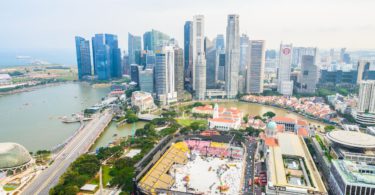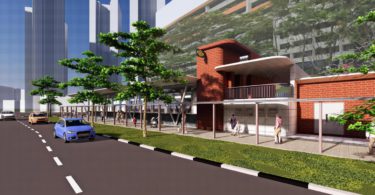By Anisa Pinatih
With the COVID-19 vaccination underway and containment measures eased in many cities in the Asia Pacific (APAC), some forecasters predicted a sharp rebound in 2021, but others are not as optimistic and expect only a mild recovery. However, most agree that prospects for 2021 look more positive than 2020 when lockdowns completely shut down economic activities.
In the real estate market, the question is whether or not a demand for spaces such as offices, commercial buildings and logistics will return to the pre-COVID states. We do not know yet for sure, but we can see how consumer preferences have shifted because of the prolonged quarantine and the now-normative work-from-home arrangements.
What already stands out is the shift from physical to online retail as e-commerce had already been on the rise before the pandemic hit, and the lockdowns just made it boom. What this means is that there may be continuous expansion in logistic offerings, warehouses and relevant infrastructure projects.
Industrial sector
In Singapore, over 21 million low-value goods through the air cargo checkpoints were cleared by the Immigration and Checkpoints Authority (ICA) in 2020, which was doubled from 10.5 million in 2019. The circuit breaker measures and travel restrictions provided the impetus for consumers to turn towards e-commerce and online shopping for their daily essentials, leisure and entertainment needs. Preference towards physical retail prevails, but there seems to be an increase in various retail concepts and formats emerging to cater to changing consumer preferences and habits.
Colliers[1] predicted that the logistics and industrial sector in APAC will continue to expand. Logistic warehouses in popular cities like Beijing and Shanghai have only limited supply, so tenants and owners may turn to locations away from these main centres. Singapore has a competitive edge in Asia’s market, with a per capita Grade A stock on a GFA basis of 0.8 square metres (compared to under 0.2 square metres in Osaka or South China). As such, Singapore may see modest average annual five-year rent growth of 0.8 per cent.
In line with Colliers, JTC Corporation[2] mentioned that, in 1Q 2021, occupancy rate for the overall industrial property market rose by 0.1 percentage points on a quarter-on-quarter basis, and 0.8 percentage points on a year-on-year basis to 90.0 per cent. Among the market segments, occupancy rates for multiple-user factory space rose, while the occupancy rates for the single-user factory, business park and warehouse segments all fell.
JTC Corporation also maintained that prices and rentals have continued to rebound in 1Q 2021, with 0.9 per cent and 0.6 per cent increase respectively as compared to the previous quarter. The 2Q 2021 may continue to see an increase and any potential rise in occupancy is likely to be tempered by new completions and an increase in supply into the market.
In Malaysia, the emergence of rubber demand for Personal Protective Equipment (PPE) and the boom of e-commerce usage have driven investments, totalling about RM37 billion since the start of the pandemic outbreak (CBRE | WTW research[3]). Some land transaction deals were also noted, such as for medical, logistics, data centres and oil, marking positive signs.
Logistics sector and warehouse demand are also rising in Malaysia. According to the report by CBRE | WTW, the sector’s outlook is positive following the latest developments of Malaysian Vision Valley (MVV) bundled with relevant infrastructure projects. About 2 million square feet of new logistic and warehousing facilities are expected to enter the Klang Valley market alone in the near future, continuing to attract foreign investments. In Melaka, German optical sensor producers, Leuze Electronic, is currently under rapid construction phase and is scheduled for completion in the first quarter of 2022.
Read: New industrial plant construction in Melaka is set to finish in the first quarter of 2022
Office sector
The COVID-19’s overall impact on office space demand and distribution remains uncertain, but people now expect more flexible work arrangements. JLL Singapore claims that the outlook for commercial real estate market, especially for the office sector, seems positive. In Singapore, the ministry of Health (MOH) announced that from 8 May 2021 to 30 May 2021, 50 per cent of employees who are able to work from home can return to the workplace at any time. But then again, if permitted, some employees may still choose to work from home unless all have been vaccinated.
Nonetheless, the situation can only get better compared to the total lockdown in 2020 and the overall demand for office space is likely to rise in the remaining 2021. JLL believes that this will lead to rent correction of less than 5 per cent in 2021, compared to the 9.2 per cent fall recorded for 2020.
Read: The propeller framework: A workplace model for the new normal
In 19 key APAC cities, however, the aggregate net absorption fell 52 per cent in 2020, whereas the aggregate supply remained high (2.1x demand) (Colliers’ report). As the supply continues to grow 50 per cent this year, the majority of regional markets will continue to see a ratio of supply higher than demand. In other words, the APAC office sector tends to be in favour of tenants over 2021 (as pricing will get lower). In a normal situation, this outlook facilitates long-term leasing deals, but with the tumultuous economy, businesses may not rush their long-term decisions.
Following APAC trends, the office demand in Malaysia will probably be lower than the supply. For example, there is an incoming supply of 6.1 million square feet of office space in Klang Valley from 12 upcoming purpose-built office buildings (CBRE | WTW research). This raises concerns of increased vacancy. The adaptation of working-from-home arrangement is also expected to become a norm in many offices in Malaysia. Office spaces and buildings, therefore, are evolving to remain relevant, such as by highlighting collaborative spaces or hotdesking. Changes like these may have implications in terms of lease structure, flexibility and pricing in the future.
Other sectors
With the rise of e-commerce, retailers will have to recalibrate their businesses and this means that their rental commitments may decline. For some, physical stores remain essential, but many have turn to cloud-based business or adopting a hybrid model. It is unlikely that upcoming retail space will achieve optimal occupancy. Hospitality buildings may also continue to struggle in reaching average room rate as tourism will not rebound anytime soon due to the closing of international borders. The sector that probably looks more positive is residential. The work-from-home arrangement may be carried forward post-pandemic and this perhaps increases the demand for larger living spaces and home offices. As for the infrastructure sector, the trends will remain upwards as many APAC countries have it in the top list of development priorities.
[1] Colliers’ Asia Pacific Property Markets: Themes for 2021
[2] JTC Quarterly Market Report – Industrial properties
[3] CBRE | WTW Real Estate Market Outlook Malaysia – Restart the uneven recovery











